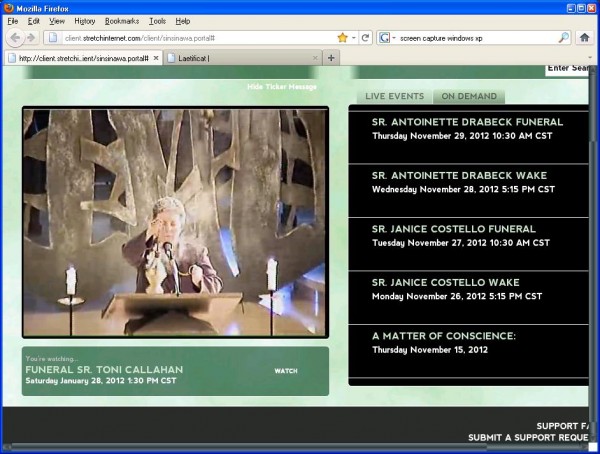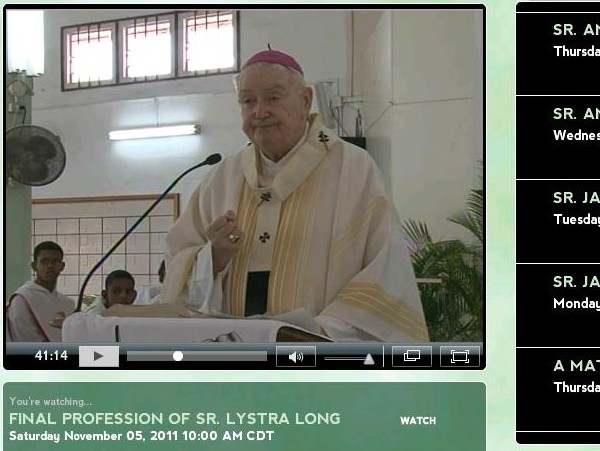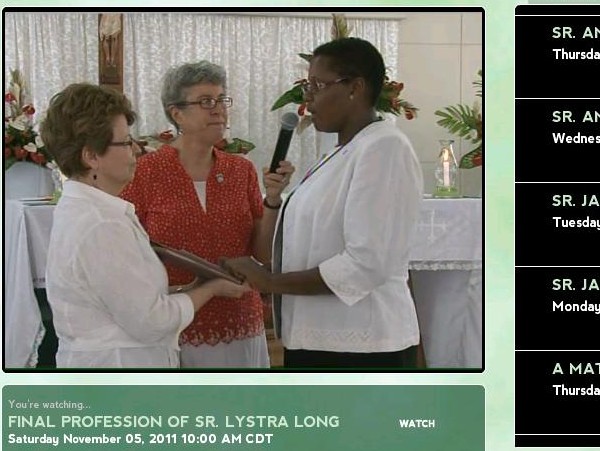
A Sister incenses the book before reading the Gospel and preaching a sermon at Mass at Sinsinawa Mound
One thing I am learning is that there is enough unusual stuff the Sinsinawa Dominicans do to provide content for a whole blog. That is NOT the point of Laetificat. I do not like that stuff. And I hold out hope that not all the Sinsinawa Dominicans are like that–it would be terrible and unfair to them, if people thought that. The fact that I looked in vain last Sunday at Sinsinawa Mound for a Sister who didn’t believe in “women priests”, doesn’t mean there aren’t any who believe as the Church believes. I strongly believe there still are, even though it’s errant ones who seem to draw attention to themselves.
All the same, people should be able to see what goes on, and the Sinsinawa Dominicans think so too, since they have put the videos online for the public. The picture above is from the video of the funeral Mass for Sr Toni Callahan, February 28th of last year. An obituary of Sr Toni appeared in the Madison Catholic Herald, and the year before the Archdiocese of Denver acknowledged her 60th anniversary in religious life. In the picture above, a Sister is incensing the book just before she reads the gospel and gives a sermon at the funeral of Sr Toni Callahan.
May Sr Toni, and all the faithful departed, through the mercy of God, rest in peace. Amen.
Sr Toni seems to have had an affinity for the new-age, panentheistic “new cosmology” promoted in that film I saw there last week, Band of Sisters. Sister homilist noted that “For Toni, all was one, all was connected from the planets to the stars in the sky to the insects on the windowsill, etc…. All is one. Even Ephesians echoes Toni’s theology. Ephesians says there is one body, one spirit, one hope, one faith, one love…. How many times in our midst did Toni stand up, unroll the scroll and cry out for justice…. Toni’s message was not always welcome or easy to hear, and Toni often did not feel heard or listened to. It takes courage to unroll the scroll and speak and witness for justice.” Sister homilist says she opened one of Toni’s books from her bookshelf and noticed this line marked from Yeats: ‘How can we know the dancer from the dance….. Toni, for us, you are the dancer, and now the dance. You who have recognized and created beauty, have become beauty. You who shaped earth on the wheel, have become earth….” etc “Toni, lead us in the dance.”
The problem of the woman giving a homily appears only in that video and not in the others on the same page, but there are also some sad abuses regarding the Eucharist which, based on the videos, are their regular practice, things which, like having a non-ordained homilist, are “reprobated”, according to Redemptionis Sacramentum.

Archbishop Edward Joseph Gilbert, CSSP gives a homily at the final religious profession of a Sinsinawa Dominican Sister, in Trinidad. Here he’s speaking about how if religious don’t have the sound foundation of faith that comes from accepting the Church’s Magisterium, it will destroy them.
There is also a video of a Mass in Trinidad, for the November 5, 2011 final profession of Sr Lystra Long, a Trinidadian woman joining the North American congregation the Sinsisnawa Dominicans. This is much more interesting and lively, and includes younger people, habit wearing Sisters of other Orders, several priests, and an Archbishop in pallium who I think is Archbishop Edward Joseph Gilbert, CSSP. The Archbishop’s homily is interesting, he’s obviously aware of the challenges of the Sinsinawa Dominicans and the precarious situation of the new Trinidad community.
He enumerates 6 criteria for religious profession in Canon Law (I think he is drawing on canon 607 – hover over that link to see quickly what it says). I was interested that he touches on the harmful witness that is given to the people when vocations or communities fail. He places special emphasis on the importance of religious living in community and with a certain level of separation from the world, which does not mean withdrawing for people, but is a witness showing it is possible to live the common life together in peace and charity, and religious life is not meant to be lived alone. “One of the things religious superiors are getting better at… is they’re insisting their people live in community. If you have people from different communities living alone, living in specialized apostolates for all the days of their life, you wonder why they became a religious, because they could do the same thing by contract, or they could do the same thing by ordination. So this is a very important thing, it’s not Lystra’s responsibility, it is the superior’s–they’re here in the front row, it’s their responsibility to facilitate community life to the degree that it’s possible–with a shortage of personnel and the need of the Church to care for people, sometimes it’s not possible, but it should be temporary if that is the fact.” The 6 points of religious life he has pointed out in Canon Law are “not negotiable, this is what the religious life is about, you take it or you leave it, you don’t rewrite it, and there are people who do that all the time, they try to rewrite it, maybe not maliciously, but the bottom line is the same… it is the responsibility of the professed to keep these elements alive all their life…. the more you can keep these elements alive in your life, the more meaning you will have in your life…. My heart to heart recommendation here is that you look at these 6 points periodically and make sure they’re alive and well, because if they’re not, neither are you.”
The Archbishop discusses the first reading from Isaiah and the crisis in the Israelite community after the devastation from the Babylonians that brought them into exile; Isaiah gives a picture of “God’s love for devastated Israel…. The question for the leadership of the people is, how could this have happened.” “With… the thousands of people who have left the religious life since the 60s and the Council, the same question comes up, how could this have happened. Because the 6 points that the Church teaches about the religious life were not accepted, and were not followed.” He says that in Isaiah, if Jerusalem wants to be what they were before with the glorious temple and beautiful city, they have to admit they are unable to be faithful without God, and they have to ask for that daily in prayer, not twice a month, but daily. God wills to rebuild Zion, with a functioning Temple, teeming with people, because it has been reconciled with God.
“It is a life sustained by growth in virtue, a life sustained by unity of belief. If you want to cut down the religious life, if you want to cut down the married life, if you want to cut down the priesthood, you undermine belief. Once you undermine belief, you undermine the foundation on which everything stands.Now is there a guarantee about this belief? and the answer is, yes. The acceptance of an apostolic Magisterium to guide you on faith matters. It doesn’t have all the answers in the world, but it has answers on faith matters, to which you will listen, and if you do you will be sustained by this foundation of faith. Now, for the people who have international experience with religious life, they know that that’s not always true. And when that happens it will tear a community apart. So when that happens, it’s up to the superiors, or up to whatever modern name they use, they have to handle the action and make sure this doesn’t spread. Because it will kill you, if it spreads.”
This local Trinidadian parish is simply lovely and charming. Please pray for Sr Lystra. I bet she’s a great person. The poignant tension of this video for me, is that the religious congregation she is joining with such generosity may not be around a lot longer–truly, and from his whole manner of gravity and sadness in the video, I think Archbishop Gilbert knows it too, though he asks us, “pray for Sr Lystra and pray for the Church” (please stop right now and say a Hail Mary). Below, Sr Lystra makes her vows to the Prioress, Mary Ellen Gevelinger:

Sister Lystra vows obedience to the Prioress of the Sinsinawa Dominican Sisters of the Most Holy Rosary, and her successors.
One thing I learned by trying to understand that video is that one of the Sinsinawa Dominicans’ 3 women in formation currently (for their aging congregation of hundreds), Gail Jagroop, is also destined for the Trinidad community of Sinsinawa Dominicans (which started a retreat house in 2012). Maybe their remnant will have a future there, if they do listen to what Archbishop Gilbert told them.

Good reporting again.
Are you certain that the Funeral was within the context of Holy Mass? If so, that is an excruciatingly obvious, very serious abuse.
The Holy See gave an authentic interpretation of Can. 767 § 1 (on May 26, 1987) that says even the local bishop may not dispense from the requirement that the homilist must be an ordained priest or deacon. The Instruction Ecclesiae de mysterio from 1997 differentiates homilies within the celebration of the Holy Eucharist and non-Eucharistic events (Article III). If they did not have an actual Mass, it is permissible for Sister to give a homily (although I highly doubt that it is ever permissible for her to incense and read from the Gospel! cf. Redemptionis Sacramentum § 63). If it was during a Mass, then it is a violation of Canon Law (Can 767 § 1), a violation of the General Instruction of the Roman Missal (§ 66), and a violation of Redemptionis Sacramentum (§§ 64 and 161). And yet they proudly post this on their website for the world to see!!!
PermalinkOh yes, it’s a Mass, I watched the whole thing (I’ll edit my post to make clear it’s a funeral Mass). And yes, just completely obviously a very bad abuse. And not the only serious abuse. The readings were extensively rewritten in feminist language. Sisters bring 2 big glass pitchers of wine to the altar. At the consecration, Father says “…the cup of My Blood which will be poured out for you and for all for the forgiveness of sins.” There is a large amount of walking around during the sign of peace, which lasts a good while, and Father leaves the sanctuary to shake hands with the congregation. During the Lamb of God there are Sisters standing at the altar pouring the Precious Blood from the glass pitchers into wine glass type glass communion cups. During the priest’s Communion there are 4 or 5 Sisters standing at the altar. Several of these things are reprobated in RS, others just strongly warned not to do that. The Eucharistic abuses seem to be consistent at all the Masses I looked at, and there are other problems too.
Vatican II, of course (Sacrosanctum Concilium) says nobody, even a priest, may add, remove or change anything in the Mass on his own authority.
PermalinkWell, there are some pretty horrendous translations that are “approved”: http://www.usccb.org/bible/approved-translations/
??? At least my Irish Catholic ancestors would wait until after Mass was over to go get drunk…. Sorry, but that was the only place I could at least try to find some humor here.
Well, to be fair, the screen-shot does say January 2012, so Father could just not have been used to the new translation yet…. I very much so doubt that’s it, but it’s possible.
GIRM 32: “However, it is appropriate that each person, in a sober manner, offer the sign of peace only to those who are nearest.”
GIRM 154: “The Priest may give the Sign of Peace to the ministers but always remains within the sanctuary, so that the celebration is not disrupted.”
Of course, in the TLM the Kiss of Peace is always omitted in any Mass of the Dead. And for good theological reason.
RS 117: “Reprobated, therefore, is any practice of using for the celebration of Mass common vessels, or others lacking in quality, or devoid of all artistic merit or which are mere containers, as also other vessels made from glass, earthenware, clay, or other materials that break easily.”
Also, at the Agnus Dei, the Precious Blood has already been consecrated! Even if they used appropriate vessels, why on earth would anyone be splashing the Most Precious Blood around between containers!?!?!?
No wonder some of these Sisters see no problem with abortion — they throw the Blood of Christ around like it was mere water. If you can’t even show respect for the Precious Blood of our Redeemer, which He shed on the Cross for the forgiveness of our sins, it’s hard to imagine being fazed by the shedding of the blood of an infant who has done nothing. Fiat misericordiam tuam super nos, Domine, quaemadmodum speravimus in te.
PermalinkSorry to double-post, but this is regarding an entirely different aspect of the post…
Good point. I’m sure there are some too. We don’t notice them because they are too busy living out their vocations as Brides of Christ. They are probably spending all their time praying for the conversion of their fallen-away Sisters. I’m sure they are a thousand times more heartbroken than any of the rest of us are about all this nonsense. I have been reading the writings of St Francis of Assisi lately. This is what the Seraphic Father says about the Vow of Holy Obedience:
May Christ take care of those dear Sisters who are faithful to the teachings of His Church, and hear their prayers and sufferings to convert those who are not!
PermalinkI know this is a silly and naive question but where’s the Bishop and his condemnation in which these serious abuses took place?
PermalinkBelieve me our Bishop is very good on correct liturgy and has to care, if he knew about it that is, and it that is the kind of thing that I think he’s actually obliged to try to correct, but normally and fittingly corrections happen privately, not out in public. That incident was a year ago and there are not any other occurrences of a non ordained homilist in the other, more recent videos. It may be that they agreed not to do that again, or then again it may be they just don’t post the videos now. My hope is that they actually stopped, if so them good for them doing the right thing. The relationship of Bishop Morlino with the Sinsinawa Dominicans is not an easy one.
PermalinkElizabeth, I too am curious about this situation. I just watched the last funeral Mass posted on their site from last November, and I would think enough time has passed that the Priest who is offering this Mass would not still be making the mistake of saying a”for all” in stead of “for many”, do you know if this abuse has stopped? Doesn’t the Madison Diocese have internet access?
PermalinkI have no knowledge of them having changed anything.
PermalinkThank you Elizabeth. Excellent job. We would be lost without you. Lord have mercy on them and us. Sorrowful.
Permalink